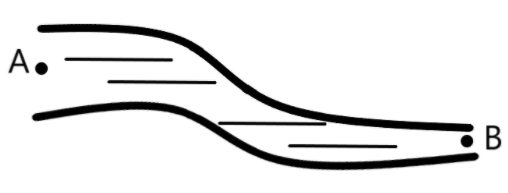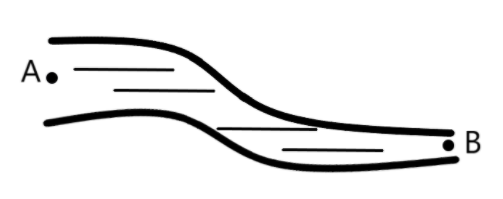Answer
414.6k+ views
Hint: Continuity equation for the flow of water suggests that the product of the speed of water and area of the cross-section at $A$ is equal to the product of the speed of water and area of the cross-section at $B$. Bernoulli’s theorem for water flow suggests that pressure difference between $A$ and $B$ is dependent on the difference in speeds of water at $A$ and $B$, the height difference between $A$ and $B$, the density of water, and acceleration due to gravity. From both these equations, the speed of the water at $B$ as well as the pressure difference between $A$ and $B$ can easily be found out.
Formula used:
$\begin{align}
& 1){{A}_{A}}{{V}_{A}}={{A}_{B}}{{V}_{B}} \\
& 2){{P}_{A}}+\dfrac{1}{2}\rho {{V}_{A}}^{2}+\rho g{{h}_{A}}={{P}_{B}}+\dfrac{1}{2}\rho {{V}_{B}}^{2}+\rho g{{h}_{B}} \\
\end{align}$
Complete step-by-step solution
We are provided with the case of water flow in a tube, as shown in the following figure.

The area of cross-section at $A$ and $B$ are $1c{{m}^{3}}$ and $0.5c{{m}^{3}}$ respectively and the height difference between $A$ and $B$ is $5cm$. If the speed of the water at $A$ is $10cm{{s}^{-1}}$, we are required to find the speed of the water at $B$ and the difference in pressure at $A$ and $B$.
From the continuity equation of water flow, we know that the product of the speed of water and area of the cross-section at $A$ is equal to the product of the speed of water and area of the cross-section at $B$. Mathematically, the equation of continuity is given by
${{A}_{A}}{{V}_{A}}={{A}_{B}}{{V}_{B}}$
where
${{A}_{A}}$ is the area of the cross-section at $A$
${{V}_{A}}$ is the speed of the water at $A$
${{A}_{B}}$ is the area of the cross-section at $B$
${{V}_{B}}$ is the speed of the water at $B$
Let this be equation 1.
Substituting the given values from the question in equation 1, we have
${{A}_{A}}{{V}_{A}}={{A}_{B}}{{V}_{B}}\Rightarrow 1c{{m}^{3}}\times 10cm{{s}^{-1}}=0.5c{{m}^{3}}\times {{V}_{B}}\Rightarrow {{V}_{B}}=\dfrac{1c{{m}^{3}}\times 10cm{{s}^{-1}}}{0.5c{{m}^{3}}}=20cm{{s}^{-1}}$
where
${{A}_{A}}=1c{{m}^{3}}$ is the area of cross-section at $A$
${{V}_{A}}=10cm{{s}^{-1}}$ is the speed of water at $A$
${{A}_{B}}=0.5c{{m}^{3}}$ is the area of cross-section at $B$
${{V}_{B}}$ is the speed of water at $B$
Let this be equation 2.
Now, we know that Bernoulli’s theorem for water flow suggests that pressure difference between $A$ and $B$ is dependent on the difference in speeds of water at $A$ and $B$, height difference between $A$ and $B$, density of water and acceleration due to gravity. Mathematically, Bernoulli’s theorem can be expressed as
${{P}_{A}}+\dfrac{1}{2}\rho {{V}_{A}}^{2}+\rho g{{h}_{A}}={{P}_{B}}+\dfrac{1}{2}\rho {{V}_{B}}^{2}+\rho g{{h}_{B}}\Rightarrow {{P}_{B}}-{{P}_{A}}=\dfrac{1}{2}\rho \left( {{V}_{A}}^{2}-{{V}_{B}}^{2} \right)+\rho g\left( {{h}_{A}}-{{h}_{B}} \right)$
where
${{P}_{A}}$ is the pressure at $A$
${{V}_{A}}$ is the speed of water at $A$
${{P}_{B}}$ is the pressure at $B$
${{V}_{B}}$ is the speed of water at $B$
${{h}_{A}}-{{h}_{B}}$ is the height difference between $A$ and $B$
$\rho $ is the density of water
$g$ is the acceleration due to gravity
Let this be equation 3.
Substituting the values given in the question and equation 2 in equation 3, we have
${{P}_{B}}-{{P}_{A}}=\dfrac{1}{2}\rho \left( {{V}_{A}}^{2}-{{V}_{B}}^{2} \right)+\rho g\left( {{h}_{A}}-{{h}_{B}} \right)=\dfrac{1}{2}{{10}^{3}}kg{{m}^{-3}}\left( {{\left( 10cm{{s}^{-1}} \right)}^{2}}-{{\left( 20cm{{s}^{-1}} \right)}^{2}} \right)+({{10}^{3}}kg{{m}^{-3}})(10m{{s}^{-2}})\left( 5cm \right)$
Simplifying the above expression, we have
\[{{P}_{B}}-{{P}_{A}}=\dfrac{1}{2}{{10}^{3}}kg{{m}^{-3}}\left( -0.03{{m}^{2}}{{s}^{-2}} \right)+500kg{{m}^{-1}}{{s}^{-2}}=-15kg{{m}^{-1}}{{s}^{-2}}+500kg{{m}^{-1}}{{s}^{-2}}=485Pa\]
Let this be equation 4.
Therefore, from equation 2 and equation 4, the speed of the water at $B$ and the pressure difference between $A$ and $B$ are $20cm{{s}^{-1}}$ and $485Pa$.
Note: Students need to be aware of the continuity equation as well as Bernoulli’s theorem for solving this question in no time. They need to be thorough with conversion formulas too. Conversion formulas used in the solution given above are
\[\begin{align}
& 1m={{10}^{2}}cm \\
& 1cm{{s}^{-1}}={{10}^{-2}}m{{s}^{-1}} \\
& 1c{{m}^{2}}{{s}^{-2}}={{10}^{-4}}{{m}^{2}}{{s}^{-2}} \\
& 1Pa=1kg{{m}^{-1}}{{s}^{-2}} \\
& \\
\end{align}\]
Also, the values of acceleration due to gravity $(g)$ and density of water $(\rho )$ are taken as $10m{{s}^{-2}}$ and $10kg{{m}^{-3}}$, respectively.
Formula used:
$\begin{align}
& 1){{A}_{A}}{{V}_{A}}={{A}_{B}}{{V}_{B}} \\
& 2){{P}_{A}}+\dfrac{1}{2}\rho {{V}_{A}}^{2}+\rho g{{h}_{A}}={{P}_{B}}+\dfrac{1}{2}\rho {{V}_{B}}^{2}+\rho g{{h}_{B}} \\
\end{align}$
Complete step-by-step solution
We are provided with the case of water flow in a tube, as shown in the following figure.

The area of cross-section at $A$ and $B$ are $1c{{m}^{3}}$ and $0.5c{{m}^{3}}$ respectively and the height difference between $A$ and $B$ is $5cm$. If the speed of the water at $A$ is $10cm{{s}^{-1}}$, we are required to find the speed of the water at $B$ and the difference in pressure at $A$ and $B$.
From the continuity equation of water flow, we know that the product of the speed of water and area of the cross-section at $A$ is equal to the product of the speed of water and area of the cross-section at $B$. Mathematically, the equation of continuity is given by
${{A}_{A}}{{V}_{A}}={{A}_{B}}{{V}_{B}}$
where
${{A}_{A}}$ is the area of the cross-section at $A$
${{V}_{A}}$ is the speed of the water at $A$
${{A}_{B}}$ is the area of the cross-section at $B$
${{V}_{B}}$ is the speed of the water at $B$
Let this be equation 1.
Substituting the given values from the question in equation 1, we have
${{A}_{A}}{{V}_{A}}={{A}_{B}}{{V}_{B}}\Rightarrow 1c{{m}^{3}}\times 10cm{{s}^{-1}}=0.5c{{m}^{3}}\times {{V}_{B}}\Rightarrow {{V}_{B}}=\dfrac{1c{{m}^{3}}\times 10cm{{s}^{-1}}}{0.5c{{m}^{3}}}=20cm{{s}^{-1}}$
where
${{A}_{A}}=1c{{m}^{3}}$ is the area of cross-section at $A$
${{V}_{A}}=10cm{{s}^{-1}}$ is the speed of water at $A$
${{A}_{B}}=0.5c{{m}^{3}}$ is the area of cross-section at $B$
${{V}_{B}}$ is the speed of water at $B$
Let this be equation 2.
Now, we know that Bernoulli’s theorem for water flow suggests that pressure difference between $A$ and $B$ is dependent on the difference in speeds of water at $A$ and $B$, height difference between $A$ and $B$, density of water and acceleration due to gravity. Mathematically, Bernoulli’s theorem can be expressed as
${{P}_{A}}+\dfrac{1}{2}\rho {{V}_{A}}^{2}+\rho g{{h}_{A}}={{P}_{B}}+\dfrac{1}{2}\rho {{V}_{B}}^{2}+\rho g{{h}_{B}}\Rightarrow {{P}_{B}}-{{P}_{A}}=\dfrac{1}{2}\rho \left( {{V}_{A}}^{2}-{{V}_{B}}^{2} \right)+\rho g\left( {{h}_{A}}-{{h}_{B}} \right)$
where
${{P}_{A}}$ is the pressure at $A$
${{V}_{A}}$ is the speed of water at $A$
${{P}_{B}}$ is the pressure at $B$
${{V}_{B}}$ is the speed of water at $B$
${{h}_{A}}-{{h}_{B}}$ is the height difference between $A$ and $B$
$\rho $ is the density of water
$g$ is the acceleration due to gravity
Let this be equation 3.
Substituting the values given in the question and equation 2 in equation 3, we have
${{P}_{B}}-{{P}_{A}}=\dfrac{1}{2}\rho \left( {{V}_{A}}^{2}-{{V}_{B}}^{2} \right)+\rho g\left( {{h}_{A}}-{{h}_{B}} \right)=\dfrac{1}{2}{{10}^{3}}kg{{m}^{-3}}\left( {{\left( 10cm{{s}^{-1}} \right)}^{2}}-{{\left( 20cm{{s}^{-1}} \right)}^{2}} \right)+({{10}^{3}}kg{{m}^{-3}})(10m{{s}^{-2}})\left( 5cm \right)$
Simplifying the above expression, we have
\[{{P}_{B}}-{{P}_{A}}=\dfrac{1}{2}{{10}^{3}}kg{{m}^{-3}}\left( -0.03{{m}^{2}}{{s}^{-2}} \right)+500kg{{m}^{-1}}{{s}^{-2}}=-15kg{{m}^{-1}}{{s}^{-2}}+500kg{{m}^{-1}}{{s}^{-2}}=485Pa\]
Let this be equation 4.
Therefore, from equation 2 and equation 4, the speed of the water at $B$ and the pressure difference between $A$ and $B$ are $20cm{{s}^{-1}}$ and $485Pa$.
Note: Students need to be aware of the continuity equation as well as Bernoulli’s theorem for solving this question in no time. They need to be thorough with conversion formulas too. Conversion formulas used in the solution given above are
\[\begin{align}
& 1m={{10}^{2}}cm \\
& 1cm{{s}^{-1}}={{10}^{-2}}m{{s}^{-1}} \\
& 1c{{m}^{2}}{{s}^{-2}}={{10}^{-4}}{{m}^{2}}{{s}^{-2}} \\
& 1Pa=1kg{{m}^{-1}}{{s}^{-2}} \\
& \\
\end{align}\]
Also, the values of acceleration due to gravity $(g)$ and density of water $(\rho )$ are taken as $10m{{s}^{-2}}$ and $10kg{{m}^{-3}}$, respectively.
Recently Updated Pages
How many sigma and pi bonds are present in HCequiv class 11 chemistry CBSE

Why Are Noble Gases NonReactive class 11 chemistry CBSE

Let X and Y be the sets of all positive divisors of class 11 maths CBSE

Let x and y be 2 real numbers which satisfy the equations class 11 maths CBSE

Let x 4log 2sqrt 9k 1 + 7 and y dfrac132log 2sqrt5 class 11 maths CBSE

Let x22ax+b20 and x22bx+a20 be two equations Then the class 11 maths CBSE

Trending doubts
Fill the blanks with the suitable prepositions 1 The class 9 english CBSE

At which age domestication of animals started A Neolithic class 11 social science CBSE

Which are the Top 10 Largest Countries of the World?

Give 10 examples for herbs , shrubs , climbers , creepers

Difference between Prokaryotic cell and Eukaryotic class 11 biology CBSE

Difference Between Plant Cell and Animal Cell

Write a letter to the principal requesting him to grant class 10 english CBSE

Change the following sentences into negative and interrogative class 10 english CBSE

Fill in the blanks A 1 lakh ten thousand B 1 million class 9 maths CBSE




